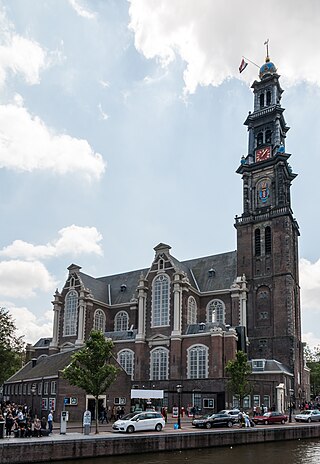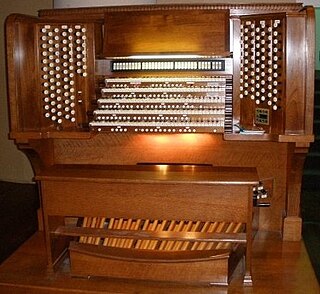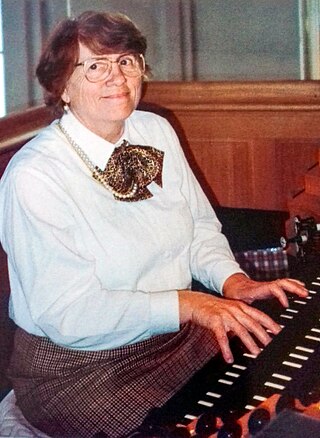Photo gallery
- The organ of the Katarina kyrka, Stockholm
- The organ of the Église Saint-Eustache, Paris.
- The organ of the Nieuwe Kerk, Katwijk aan Zee.
| Company type | Organ builder |
|---|---|
| Industry | Pipe organ construction and restoration |
| Founded | 1967 |
| Headquarters | , |
Key people | Jan L. and Peter van den Heuvel |
| Products | New and restored pipe organs |
| Services | Maintenance and restoration of old organs; construction of new organs |
| Website | http://vandenheuvel-orgelbouw.nl/English.htm |
J. L. van den Heuvel Orgelbouw is a firm of pipe organ builders, based in Dordrecht, Netherlands. The company specialises in the construction of instruments in the French Symphonic tradition.
Jan van den Heuvel had, from early childhood, felt an affinity with symphonic organ music. Jan founded his organ building company in 1967 at the age of twenty (this made him the youngest organ builder in the Netherlands), having spent four years in training with Flentrop in Zaandam, where he persisted in his championship of the romantic organ in the face of Dirk Andries Flentrop's neo-Baroque ideals. [1]
Jan constructed his first organ (one manual and pedals, 10 stops) in 1967, attracting immediate critical acclaim for its voicing and high build standard. The actual construction took place in the workshop belonging to his father, a painter. He was commissioned to build a new three manual organ of 32 stops for the Singelkerk at Ridderkerk as a result of the many positive reactions to this first instrument - a significant milestone in the young organ-builder's career, as he was responsible not only for the design and construction of the instrument, but also for the richly carved organ case. [2] The commissioning of this instrument necessitated the construction of a new workshop, which Jan himself designed. The instrument attracted widespread praise, leading to numerous orders for new organs and restoration of existing instruments. A new organ of two manuals and 33 stops was commissioned for the Lambertuskerk, Strijen, which was delivered in 1975, the year in which Jan's 17-year-old brother Peter joined the firm. [3] Expansion of the business, with further enlargement of the workshops, was underpinned by receipt of a volume of new contracts for large organs. Particularly worthy of mention amongst these are the instruments in the Nieuwe Kerk, Katwijk aan Zee, l'Église Saint-Eustache, Paris (the largest organ in France), the Victoria Hall in Geneva and the Katarina kyrka in Stockholm (the last two buildings now restored after being gutted by fire) and the DR-BYEN Hall in Copenhagen.
Both Jan and Peter van den Heuvel were for a number of years interested in nineteenth century French organ building, as well as the traditions previously practiced in the Netherlands. Their contact with French organists such as Michelle Leclerc and Daniel Roth spurred them on to further studies on the Aristide Cavaillé-Coll organs. This led to numerous visits to France, not only to study and evaluate famous Cavaille-Coll organs (such as St. Sulpice, Notre-Dame and Sacré-Cœur in Paris). [4] The brothers developed Cavaillé-Coll's own schemes to establish a style of organ that was entirely their own, but completely inspired by the French Symphonic tradition. This ethos continues to this day. However, not only does the firm specialise in French-style instruments, but they have also built organs in traditional Dutch style.
| Date | Country | Place | Building | Size | Comments |
|---|---|---|---|---|---|
| 1970 | NL | Ridderkerk | Singelkerk | IIIP/32 | J. L. van den Heuvel's first major commission |
| 1979 | NL | Katwijk aan Zee | Nieuwe Kerk | IVP/80 | One of the Netherlands' largest organs |
| 1989 | FR | Paris | Église Saint-Eustache | VP/101 | The largest organ in France |
| 1992 | CH | Geneva | Victoria Hall | IVP/71 | The only van den Heuvel organ in Switzerland |
| 1993 | GB | Glasgow | St Aloysius Church, Glasgow | IIP/24 | The only van den Heuvel organ in Britain - formerly at Royal Academy of Music, Dukes' Hall, London |
| 1994 | USA | New York City | Church of the Holy Apostles | IIIP/32 | The first vdH organ in the USA. Originally in Castle Shiloah, TX. |
| 1995 | SE | Stockholm | Kungliga Musikhögskolan | IIIP/25 | The first van den Heuvel organ in Sweden. |
| 1995 | NL | Rotterdam | Maranatha Kerk | IIIP/25 | The Musikhögskolan's twin, built for another buyer who pulled out |
| 1997 | DE | Berlin | St Franziskus Kirche | IIIP/51 | The only van den Heuvel organ in Germany |
| 2000 | SE | Stockholm | Katarina Kyrka | IIIP/62 | Replaced a 1976 Åkerman & Lund organ destroyed by fire in 1990 |
| 2000 | NL | The Hague | Residence of Ben van Oosten | IIIP/16 | vdH's first commission for a house-organ from a famous organist |
| 2000 | FI | Mänttä | Church | IIIP/30 | The only vdH organ in Finland: also, their only totally enclosed organ |
| 2006 | DK | Copenhagen | Copenhagen Concert Hall | IVP/91 | The only van den Heuvel organ in Denmark. Inaugurated in 2009. |

Charles-Marie-Jean-Albert Widor was a French organist, composer and teacher of the late Romantic era. As a composer he is known for his ten organ symphonies, especially the toccata of his fifth organ symphony, which is frequently played as recessional music at weddings and other celebrations.

The pipe organ is a musical instrument that produces sound by driving pressurised air through the organ pipes selected from a keyboard. Because each pipe produces a single pitch, the pipes are provided in sets called ranks, each of which has a common timbre, volume, and construction throughout the keyboard compass. Most organs have many ranks of pipes of differing pitch, timbre, and volume that the player can employ singly or in combination through the use of controls called stops.

The Westerkerk is a Reformed church within Dutch Protestant Calvinism in central Amsterdam, Netherlands. It lies in the most western part of the Grachtengordel neighborhood, next to the Jordaan, between the Prinsengracht and Keizersgracht.

Aristide Cavaillé-Coll was a French organ builder. He has the reputation of being the most distinguished organ builder of the 19th century. He pioneered innovations in the art and science of organ building that permeated the profession and influenced the course of organ building, composing and improvising through the early 20th century.

François-HenriClicquot was a French organ builder and was the grandson of Robert Clicquot and son of Louis-Alexandre Cliquot, who were also noted organ builders.

The Nieuwe Kerk is a 15th-century church in Amsterdam located on Dam Square, next to the Royal Palace. Formerly a Dutch Reformed Church parish, it now belongs to the Protestant Church in the Netherlands.

Katarina kyrka is one of the major churches in central Stockholm, Sweden. The original building was constructed 1656–1695. It has been rebuilt twice after being destroyed by fires, the second time during the 1990s. The Katarina-Sofia borough is named after Katarina Parish and the neighbouring parish of Sofia.

The symphonic organ is a style of pipe organ that flourished during the first three decades of the 20th century in town halls and other secular public venues, particularly in the United States and the United Kingdom. It has roots in 19th-century Europe, and is a variation of the classical pipe organ. It features expanded capabilities, with many pipes imitative of orchestral instruments, and with multiple expressive divisions and organ console controls for seamlessly adjusting volume and tone, generally with electric organ actions and winding. These expansions let the organist approximate a conductor's power to shape the tonal textures of Romantic music and orchestral transcriptions. These organs are generally concert instruments as opposed to church organs. The symphonic organ has seen a revival in the US, Europe and Japan, particularly since the 1980s.

Katwijk aan Zee is a seaside resort located on the North Sea at the mouth of the Oude Rijn. It is situated in the municipality of Katwijk and the province of South Holland.

St. Nicholas Church is a Roman Catholic church, as well as one of the oldest and most prominent landmarks in Ghent, Belgium. Begun in the early 13th century as a replacement for an earlier Romanesque church, construction continued through the rest of the century in the local Scheldt Gothic style. Typical of this style is the use of blue-gray stone from the Tournai area, the single large tower above the crossing, and the slender turrets at the building's corners.
Bernardus Franciscus van Oosten is a Dutch organist, pedagogue and author. He is titular organist of the Grote Kerk in his hometown of The Hague and is an organ professor at Rotterdam Conservatoire.
Johann Heinrich Hartmann Bätz was a Dutch organ builder.
Van den Heuvel is a Dutch toponymic surname meaning "from the hill". In the Netherlands 20,583 people carried the name in 2007, making it the 31st most common surname. The name is sometimes concatenated as vanden Heuvel,VandenHeuvel or Van De Heuvel. Notable people with the surname include:
Marcussen & Søn, also known as Marcussen and previously as Marcussen & Reuter, is a Danish firm of pipe organ builders. They were one of the first firms to go back to classical organ-building techniques, and have been producing mechanical-action organs since 1930. Aside from their many instruments in Denmark, they have built organs in northern Germany, Sweden, Finland, the Netherlands, Great Britain, South Africa, Japan, and the United States.

Rombout Verhulst was a Flemish sculptor and draughtsman who spent most of his career in the Dutch Republic. An independent assistant of the Flemish sculptor Artus Quellinus the Elder in the sculptural decoration project for the new town hall in Amsterdam, he contributed to the spread of the Baroque style in Dutch sculpture. He became the leading sculptor of marble monuments, including funerary monuments, garden figures and portraits, in the Dutch Republic.

Dirk Andries Flentrop was a Dutch organ builder. He built or restored many major organs in the United States and in Europe. He was noted for his 1977 restoration of two organs from the 17th and 18th centuries in the Mexico City Metropolitan Cathedral.

The great organ of the cathedral of Nancy was begun in 1756. It is placed on a gallery above the central doorway of the Notre-Dame-de-l'Annonciation cathedral in Nancy.

The Heuvelse kerk is a neo-Gothic Catholic church in the center of the Dutch city Tilburg. Dedicated to Saint Joseph, it is one of two major Catholic churches in the city center together with the Heikese kerk. It is located along the square Heuvel, after which it is named. A 1921 statue of the Sacred Heart is located in front of the building.

Odile Marie-Pascale Pierre was a French organist, composer and academic teacher. She was the organist at La Madeleine, Paris, and taught organ and improvisation at the Conservatoire de Paris. The last student of Marcel Dupré, she played around 2,000 recitals internationally and made recordings.

St Willibrordus is a basilica located in the center of the fortress city of Hulst in the east of Zeelandic Flanders, the Netherlands. The church is dedicated to the missionary St. Willibrord, often called the apostle of the Benelux countries. Although the nave dates from the 13th to 15th centuries, the central tower was destroyed several times, most recently in the Second World War. The current tower's modern appearance dates from the 1950s. The church contains the painting The Good Samaritan by Jan Baptist Maes (1794–1856) from Ghent. The scenes of the Way of the Cross were painted by Jan Jozef Deloose (1769–1849) from Sint-Niklaas. The frames are by the Ghent sculptor P. Pauwels.